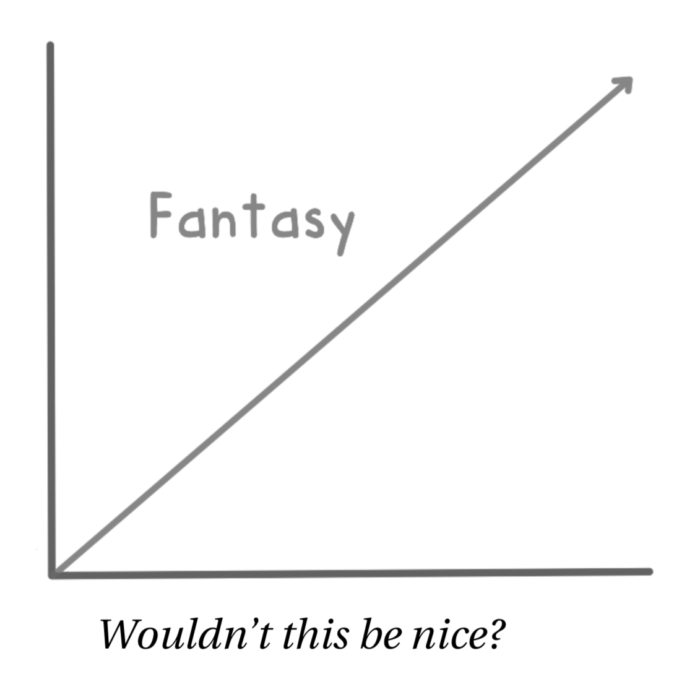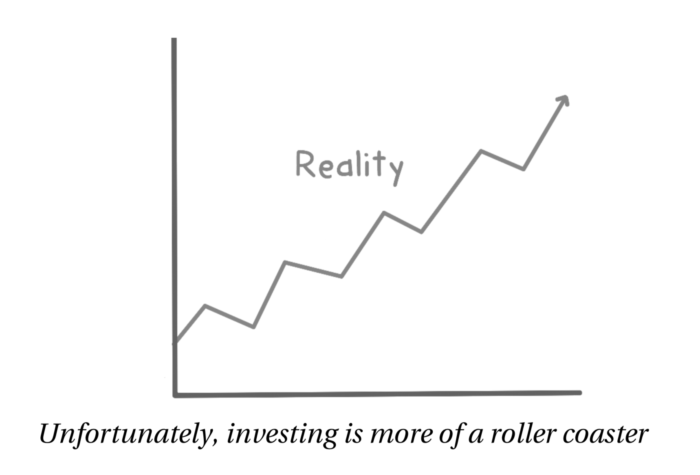
Investing. You buy some stocks and mutual funds and watch your money grow like this over time.

This is not what happens though. This is more like what happens.

What does this represent?
This shows the value of your portfolio, or maybe just a stock or mutual fund. Basically, it shows how the prices of your investments change all the time. When the stock market is open, you can see how your investments are doing in real time. Up, down, up, up, down, up. Prices move. This is called volatility. An investment with no volatility means the price never changes. It’s always the same. An investment with high volatility means the investment experiences big price changes day-to-day, week-to-week, and month-to-month.
So let’s talk about these ups and downs.
What if you had money invested and you woke up and saw on the news that the stock market was down 10% that day? And then you looked at your portfolio and saw you were down big, too? What would you be thinking? What would you be feeling? This gets to the heart of our comfort level with big swings in the value of our portfolio and investments. Of course, no one minds big moves up. That is universally accepted as a good thing! No, we’re talking about the big drops. When you go online and see losses, maybe big losses in a day or maybe when you are reviewing your monthly statement. “I lost how much?!” That, my friend, is volatility.
As an investor, that is something we must live with. Unless you leave your money in cash or buy CDs from your bank, investments can go up and down. Of course, over time, we anticipate they will go up in value, otherwise we would never buy them to begin with, but they can, and will, go down in value, too.
How much does it bother you to see losses?
On a scale of 1 to 10, where 1 is, “I can’t sleep and all I can think about is how much money I’ve lost,” and 10 is, “Whatever. Investments go up, they go down. It’s all part of investing,” what number are you?
What we’re talking about is risk tolerance.
How much risk or volatility can you tolerate before you freak out? How much up and down can you handle without it being a big deal?
Some people see the market drop 10% and they start thinking about living under a bridge and eating from a garbage can, whereas other people see the market drop 10% and start thinking, “This is great because now I can buy some investments on sale!” Same event, two completely different reactions.
There are questionnaires and online tools available that aim to help you determine your risk tolerance. “But why? Who cares?” you might ask.
Well, it turns out knowing your risk tolerance is actually pretty important, and it can actually make you a better investor and help you make more money.
Intrigued now? Maybe I should have started this lesson with that line. Anyway, in the next lesson, I’ll show you how it works.
The proceeding blog post is an excerpt from Get Money Smart: Simple Lessons to Kickstart Your Financial Confidence & Grow Your Wealth, available now on Amazon.


About the Independent Financial Advisor
Robert Pagliarini, PhD, CFP® has helped clients across the United States manage, grow, and preserve their wealth for nearly three decades. His goal is to provide comprehensive financial, investment, and tax advice in a way that is honest and ethical. In addition, he is a CFP® Board Ambassador, one of only 50 in the country, and a fiduciary. In his spare time, he writes personal finance books. With decades of experience as a financial advisor, the media often calls on him for his expertise. Contact Robert today to learn more about his financial planning services.



